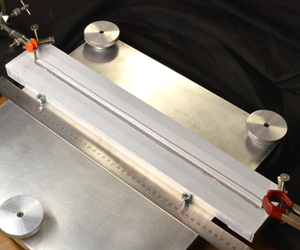Article contents
Surface waves along liquid cylinders. Part 1. Stabilising effect of gravity on the Plateau–Rayleigh instability
Published online by Cambridge University Press: 18 March 2020
Abstract

We study the shape and the geometrical properties of sessile drops with translational invariance (namely ‘liquid cylinders’) deposited upon a flat superhydrophobic substrate. We account for the flattening effects of gravity on the shape of the drop using a pendulum rotation motion analogy. In the framework of the inviscid Saint-Venant equations, we show that liquid cylinders are always unstable because of the Plateau–Rayleigh instability. However, a cylindrical drop deposited upon a superhydrophobic non-flat channel (here, wedge-shaped channels) is stabilised beyond a critical cross-sectional area. The critical threshold of the Plateau–Rayleigh instability is analytically computed for various profiles of the channel. The stability analysis is performed in terms of an effective propagation speed of varicose waves. Experiments are performed in order to test these analytical results. We measure the critical drop size at which breakup occurs, together with the decreasing effective propagation speed of varicose waves as the threshold is approached. Our theoretical predictions are in excellent agreement with the experimental measurements.
- Type
- JFM Papers
- Information
- Copyright
- © The Author(s), 2020. Published by Cambridge University Press
References
- 6
- Cited by




